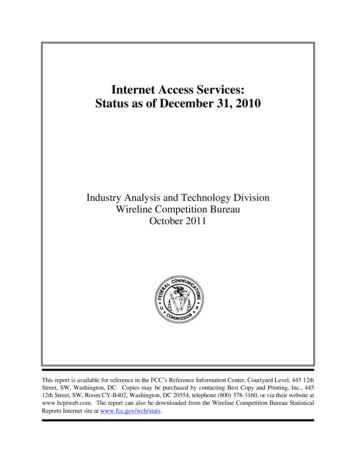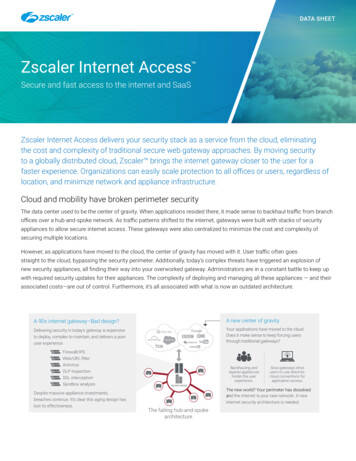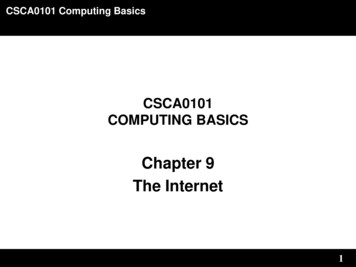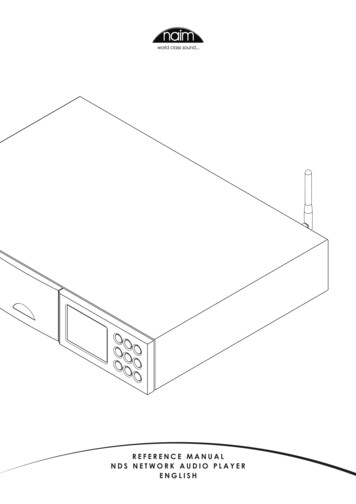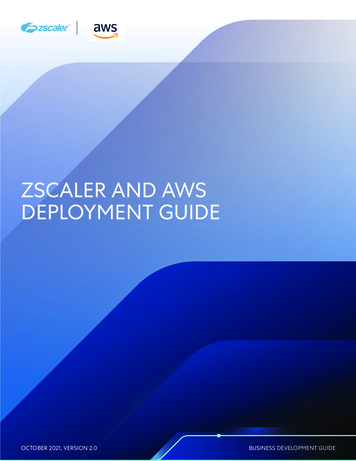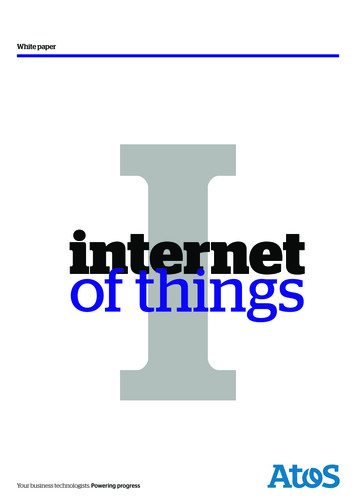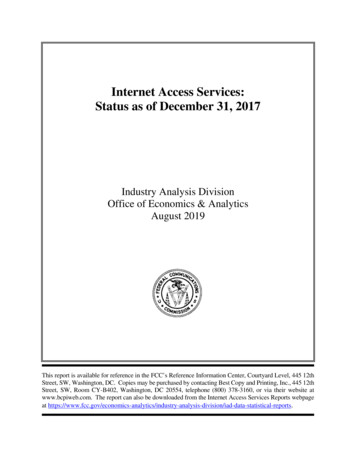
Transcription
Internet Access Services:Status as of December 31, 2017Industry Analysis DivisionOffice of Economics & AnalyticsAugust 2019This report is available for reference in the FCC’s Reference Information Center, Courtyard Level, 445 12thStreet, SW, Washington, DC. Copies may be purchased by contacting Best Copy and Printing, Inc., 445 12thStreet, SW, Room CY-B402, Washington, DC 20554, telephone (800) 378-3160, or via their website atwww.bcpiweb.com. The report can also be downloaded from the Internet Access Services Reports webpageat nalysis-division/iad-data-statistical-reports.
TABLE OF CONTENTSSECTION 1: OVERVIEW & HIGHLIGHTS .1Introduction .1Total Connections .2Figure 1Fixed and Mobile Connections by Speed 2014-2017 .2Connections by Speed .3Figure 2(a) Distribution of Fixed Connections by Downstream Speed.3Figure 2(b) Distribution of Fixed Connections by Upstream Speed .4Figure 3Fixed Connections by Speed 2014-2017 .5Number of Providers by Census Block .6Figure 4Percentages of Developed Census Blocks in which ProvidersReport Deployment of Residential Fixed Broadband .6Internet Access Subscribership .7Figure 5Fixed Connections 2002-2017 .7Other Report Highlights.8SECTION 2: SUMMARY STATISTICS - THE NATION .10SECTION 3: SUMMARY STATISTICS - THE STATES .28SECTION 4: SUMMARY STATISTICS - COUNTIES AND CENSUS TRACTS .38SECTION 5: CORRELATION RESULTS - DEMOGRAPHIC MEASURES .48Technical Notes .55Glossary .58
SECTION 1: OVERVIEW & HIGHLIGHTSIntroductionThis report summarizes information about Internet access connections in the United States as ofDecember 31, 2017 as collected by FCC Form 477. For purposes of this report, Internet accessconnections are those in service, over 200 kilobits per second (kbps) in at least one direction, and reportedto the FCC through Form 477. 1The report includes data on total and residential Internet access connections by downstream and upstreamspeed, by technology, by geography, and over time. Section 2 of the report presents nationwide statistics,Section 3 provides state-level data, and Section 4 includes data on the subscribership differences amongcounties and census tracts. 2 In addition, Section 5 of the report includes an analysis of the correlationsbetween subscribership ratios and various demographic measures. 3 Maps depicting the number of fixedconnections per 1,000 households by census tract are available online at s-reports.1See the Technical Notes and Glossary at the end of this report for more-detailed information about the Form 477data collection and the meaning of terms used in this report. Note that the Form 477 data for the June 30, 2014filing period were not subject to typical quality checks. See Internet Access Services: Status as of December 31,2014 (March 2016) at 2, available at https://apps.fcc.gov/edocs public/attachmatch/DOC-338630A1.pdf. Inaddition, the figures on mobile broadband subscribership by speed tier (formerly Figures 4(a), 4(b), and 12) havebeen removed to maintain firm confidentiality.2The Commission began collecting census tract-level data for data as of December 31, 2008. See High-SpeedServices for Internet Access: Status as of December 31, 2008 (February 2010) at 1-4, available ces-internet-access-reports (December 2008 High-Speed Report).3Publicly-available data that are too voluminous to include in this report are available online nal-data.1
Total Connections As shown in Figure 1, total Internet connections increased by about 4% between December 2016and December 2017 to 421 million. Mobile Internet connections increased 4.5% year-over-yearto 313 million in December 2017, while fixed connections grew to 108 million – up about 2%from December 2016. Although Mobile Internet connections were revised upward for our last report, we believe thisnumber remains underreported by as much as 5% through December 2017.Figure 1Fixed and Mobile Connections 00.298.2312.8300Connections in Jun2015Dec2015Jun2016Dec2017FixedMobileThe Commission approved changes to the Form 477 in June 2013 that affect the data beginning in June 2014 (see Technical Notes).Some previously-published data may have been revised. Figures may not sum to totals elsewhere in this report due to rounding.Connections include both residential and business connections.2
Connections by SpeedFixed connections – downstream speeds. Figure 2(a) illustrates how the 108 million fixed connectionsreported for Decmeber 2017 were distributed across the five groups of downstream speeds defined bybreakpoints at 3 Mbps, 10 Mbps, 25 Mbps, and 100 Mbps.Figure 2(a)Distribution of Fixed Connections (108.2 million) by Downstream Speedas of December 31, 20172.8%37.5%11.2%16.9%31.5%Downstream Speed 4Less than 3 Mbps (3.1 million)At least 3 Mbps & less than 10 Mbps (12.1 million)At least 10 Mbps & less than 25 Mbps (18.3 million)At least 25 Mbps & less than 100 Mbps (34.1 million)At least 100 Mbps (40.6 million)In December 2017, 3% of fixed connections (or 3 million connections) were slower than 3 Mbpsdownstream, 11% (or 12 million connections) were at least 3 Mbps downstream but slower than10 Mbps, 17% (or 18 million connections) were at least 10 Mbps downstream but slower than 25Mbps, 32% (or 34 million connections) were at least 25 Mbps downstream but slower than 100Mbps, and 38% (or 41 million connections) were at least 100 Mbps. 4See Figure 9.3
Fixed connections – upstream speeds. Figure 2(b) illustrates how the 108 million fixed connectionsreported for December 2017 were distributed across the four groups of upstream speeds defined bybreakpoints at 1 Mbps, 3 Mbps, and 6 Mbps.Figure 2(b)Distribution of Fixed Connections (108.2 million) by Upstream Speedas of December 31, 201710.1%45.0%17.6%27.3%Upstream Speed Less than 1 Mbps (10.9 million)At least 1 Mbps & less than 3 Mbps (19.1 million)At least 3 Mbps & less than 6 Mbps (29.5 million)At least 6 Mbps (48.7 million)In December 2017, 10% of fixed connections (or 11 million connections) were slower than 1Mbps upstream, 18% (or 19 million connections) were at least 1 Mbps upstream but slower than3 Mbps, 27% (or 30 million connections) were at least 3 Mbps upstream but slower than 6 Mbps,and 45% (or 49 million connections) were at least 6 Mbps upstream. 5Fixed connections by downstream speed over time. Figure 3 illustrates how the composition of total fixedInternet connections by different speed groups has changed from 2014 to 2017.5Ibid.4
Figure 3Fixed Connections by Downstream Speed ions in c2016Jun2017Dec20170Dec2014Jun2015Dec201512.1At least 100 MbpsAt least 25 Mbps and less than 100 MbpsAt least 10 Mbps and less than 25 MbpsAt least 3 Mbps and less than 10 MbpsLess than 3 MbpsThe Commission approved changes to the Form 477 in June 2013 that affect the data beginning in June 2014 (see Technical Notes).Some previously-published data may have been revised. Figures may not sum to totals elsewhere in this report due to rounding.Connections include both residential and business connections. The percentage of fixed connections with a downstream speed of at least 25 Mbps has grownfrom 44% (or 44 million connections) in December 2014 to 69% (or 75 million connections) inDecember 2017. Over the same period, the percentage of fixed connections with slowerdownstream speeds of less than 3 Mbps has decreased from 8% (or 8 million connections) inDecember 2014 to 3% (or 3 million connections) in December 2017.5
Number of Providers by Census BlockIn Figure 4, we show the percentage of “developed” census blocks – blocks that contain housing units –with zero, one, two, or three or more fixed broadband providers offering residential Internet accessservice at different speeds in December 2017. This information is taken from the block-level Form 477fixed broadband deployment data that the Commission began collecting in 2014. 6 A provider that reportsoffering service in a particular census block may not offer service, or service at that speed, to all locationsin the census block. Accordingly, the number of providers shown in Figure 4 does not necessarily reflectthe number of choices available to a particular household and does not purport to measure competition.Figure 4Percentages of Developed Census Blocks in which Providers Reported the Deployment ofResidential Fixed Broadband as of December 31, 2017100928473521Percentage of Census Blocks with Housing Units90804470605040303123201410750At least 3 Mbpsdownstream and at least768 kbps upstream*0 ProvidersAt least 10 Mbpsdownstream and at least1 Mbps upstream*1 ProviderAt least 25 Mbpsdownstream and at least3 Mbps upstreamAt least 100 Mbpsdownstream and at least10 Mbps upstream2 Providers3 Providers* Satellite service providers are included in this analysis. Satellite service providers report offering Internet access at bandwidthsof at least 25 Mbps downstream and 3 Mbps upstream in 99.8% of developed census blocksColumn figures may not sum to 100% due to rounding. Developed census blocks are those with housing units based on the 2010census.6Download these data and explore the interactive map at https://broadbandmap.fcc.gov/#/.6
Internet Access SubscribershipFigure 5 illustrates the number of total and residential fixed Internet access connections (connections over200 kbps in at least one direction except mobile wireless connections), as well as the number of totalfixed connections per 100 persons and the number of residential fixed connections per 100 households,since 2002. 7Figure 5Fixed Connections 2002-2017(Connections over 200 kbps in at least one direction)110,000100100,0009090,000Connections in 0,0002020,0001010,00000 Connections per 100 Units80Residential Fixed Connections (left axis)Total Fixed Connections (left axis)Residential Fixed Connections per 100 Households (right axis)Total Fixed Connections per 100 Population (right axis)Between December 2007 and December 2017, total (business and residential) fixed connectionsgrew from 70 million connections to 108 million connections – at a compound annual growth rateof 4% per year. 87For data through December 2004, only those providers with at least 250 connections in a state were required toreport. Historical fixed-location connection counts not included in this report may be found in June 2008 HighSpeed Report at Tables 1 and 3, available in Excel format at ices-internet-access.8The compound annual growth rate (CAGR) is a smoothed rate of growth calculated in three steps: divide theending value by the beginning value; raise the result of that division to a power equal to one divided by the numberof years in the period (in this case, 10 years, so the power is 1/10); subtract the number one from the result of thesecond step.7
Over the same ten-year period, residential fixed connections grew from 65 million connections to99 million connections – also at a compound annual growth rate of 4% per year. From June 2007 to June 2017, the number of residential fixed connections per 100 U.S.households increased from 51 to 75. 9Other Report HighlightsTypical speeds The median downstream speed of all reported fixed connections was 60 Mbps and the medianupstream speed was 5 Mbps. For residential fixed connections, the median downstream speedwas 60 Mbps and the median upstream speed was 5 Mbps.Residential connections Residential fixed Internet access connections increased by about 2% between December 2016 andDecember 2017, to 99 million. See Figure 7. Residential (non-business) mobile wireless Internet access connections on mobile devices withdata plans for full Internet access increased by 5%, to 266 million, between December 2016 andDecember 2017. See Figure 7. Approximately 85% of residential fixed connections had a speed of at least 10 Mbps downstreamand 1 Mbps upstream in December 2017, while 70% had a speed of at least 25 Mbps downstreamand 3 Mbps upstream. About 39% percent of all residential fixed connections had a downstreamspeed of at least 100 Mbps. See Figures 10 and 27. As a national average in December 2017, there were 71 residential fixed connections with speedsof at least 10 Mbps downstream and 1 Mbps upstream per 100 households; 58 residential fixedconnections with speeds of at least 25 Mbps downstream and 3 Mbps upstream per 100households; and 27 residential fixed connections with speeds of at least 100 Mbps downstreamand 10 Mbps upstream per 100 households. 10 See Figure 32.9We calculate residential fixed connections per 100 households using, in the denominator, U.S. household estimatesfrom the Census Bureau’s Current Population Survey (CPS) for July of each year and, for Puerto Rico and the otherinhabited island areas, Census 2010 households for 2010 and later years and Census 2000 households for the earlieryears. (The CPS also estimates U.S. households for March and November of each year.) Figure 5 also shows total(business and residential) fixed connections per 100 population, which we calculate using U.S. Census Bureaupopulation estimates for the United States and Puerto Rico – which are as of July 1 each year – and, for theremaining inhabited island areas, Census 2010 population for 2010 and later years and Census 2000 population forthe earlier years. This statistic incorporates connections to business locations into a comparison to persons. (Wenote that the ratio of accurately-measured residential fixed connections to population has a maximum value for anygiven country and point in time – the value when every household is connected – if we assume that no householdwould have more than one fixed connection to its premises. For the United States in June, for example, themaximum value would be 39 because there were about 129 million households in the United States and inhabitedinsular areas and a population of about 329 million according to the sources used for Figure 5.)10Increases over time in the ratio of residential fixed connections to households indicate that increasing shares ofhouseholds are connected at home. The ratio is somewhat different from the “take rate” of offered service (whichmay also be called an “adoption rate”) because some households may be located in areas where no fixed-locationservice is offered. These methodological differences are discussed in greater detail in Inquiry Concerning the8
Census tract and county shares of households with reportable connections We estimate the share of households with fixed Internet access connections in individual censustracts and counties as of December 31, 2017. 11 We continue to observe substantial variationamong these estimates. See Figures 37 and 39.Household subscribership rates and demographics The report includes charts that illustrate correlations between household subscribership rates anddemographic measures. We update charts based on income, household density, education andage. The data indicate that some demographic variables are correlated with Internet accesssubscribership rates. See Figures 44-49.Deployment of Advanced Telecommunications Capability to All Americans in a Reasonable and Timely Fashion,and Possible Steps to Accelerate Such Deployment Pursuant to Section 706 of the Telecommunications Act of 1996,Amended by the Broadband Data Improvement Act, GN Docket No.11-121, Eighth Broadband Progress Report, 27FCC Rcd 10342, 10386, para. 94 (2012).11For both census tracts and counties, we continue to find estimates above 100% for the share of households withfixed Internet access connections. See p. 57 for more information.9
SECTION 2SUMMARY STATISTICS: THE NATIONTable of ContentsFigure 6Connections over 200 kbps in at Least One Direction 2013-2017 . 12Figure 7Residential Connections over 200 kbps in at Least OneDirection 2013-2017 . 12Figure 8Residential Fixed Connections by Speed 2013-2017 . 13Figure 9Distribution of Fixed Connections over 200 kbps in at Least OneDirection as of December 31, 2017 . 14Figure 10Distribution of Residential Fixed Connections over 200 kbps in at LeastOne Direction as of December 31, 2017 . 15Figure 11Connections over 200 kbps in at Least One Direction by Technology2013-2017 . 16Figure 12Connections by Technology as of December 31, 2017 . 16Figure 13Residential Connections over 200 kbps in at Least One Direction by Technology2013-2017 . 17Figure 14Residential Connections by Technology as of December 31, 2017 . 17Figure 15Fixed Connections at Least 3 Mbps Downstream and 768 kbps Upstream byTechnology 2013-2017 . 18Figure 16Residential Fixed Connections at Least 3 Mbps Downstream and 768 kbpsUpstream by Technology 2013-2017 . 18Figure 17Fixed Connections at Least 10 Mbps Downstream and 1 Mbps Upstream byTechnology 2014-2017 . 19Figure 18Fixed Connections at Least 10 Mbps Downstream and 1 Mbps Upstream byTechnology as of December 31, 2017 . 19Figure 19Residential Fixed Connections at Least 10 Mbps Downstream and 1 MbpsUpstream by Technology 2014-2017 . 20Figure 20Residential Fixed Connections at Least 10 Mbps Downstream and 1 MbpsUpstream by Technology as of December 31, 2017. 20Figure 21Fixed Connections at Least 25 Mbps Downstream and 3 Mbps Upstream byTechnology 2014-2017 . 21Figure 22Fixed Connections at Least 25 Mbps Downstream and 3 Mbps Upstream byTechnology as of December 31, 2017 . 21Figure 23Residential Fixed Connections at Least 25 Mbps Downstream and 3 Mbps Upstreamby Technology 2014-2017 . 22Figure 24Residential Fixed Connections at Least 25 Mbps Downstream and 3 Mbps Upstreamby Technology as of December 31, 2017 . 22Figure 25Residential Fixed Connections over 200 kbps in at Least One Direction byTechnology 2013-2017 (Shares of Selected Technologies) . 2310
Figure 26Residential Fixed Connections over 200 kbps in at Least One Direction byTechnology 2013-2017 (Net Adds for Selected Technologies) . 23Figure 27Residential Fixed Connections by Technology as of December 31, 2017(Shares of Selected Technologies for Selected Speeds) . 24Figure 28Fixed Connections by Downstream Speed Tier and Technology as ofDecember 31, 2017 . 25Figure 29Residential Fixed Connections by Downstream Speed Tier and Technology as ofDecember 31, 2017 . 26Figure 30Nationwide Number of Providers of Connections over 200 kbps in at Least OneDirection by Technology 2013-2017 . 27Figure 31Nationwide Number of Providers of Connections over 200 kbps in at Least OneDirection - Selected Technologies 2013-2017 . 2711
Figure 6Connections over 200 kbps in at Least One Direction 2013-2017(In thousands)2013TechnologyTotalTotal FixedMobile 434273,679291,516299,256302,562312,778Figure 7Residential Connections over 200 kbps in at Least One Direction 2013-2017(In thousands)2013TechnologyTotalTotal FixedMobile ,122246,537253,000255,986266,208* The June 2014 data have not been subjected to the typical quality checks (see Technical Notes).The Commission approved changes to the Form 477 in June 2013 that affect the data beginning in June 2014 (see Technical Notes). Some previously-publisheddata may have been revised. Figures may not sum to totals elsewhere in this report due to rounding.12
Figure 8Residential Fixed Connections by Downstream Speed .628.239.011.99.232.535.637.238.57536.4Connections in ec2015Jun20162.8Dec2016Jun2017At least 100 MbpsAt least 25 Mbps and less than 100 MbpsAt least 10 Mbps and less than 25 MbpsAt least 3 Mbps and less than 10 MbpsLess than 3 MbpsThe Commission approved changes to the Form 477 in June 2013 that affect the data beginning in June 2014 (see Technical Notes). Somepreviously-published data may have been revised. Figures may not sum to totals elsewhere in this report due to rounding.1310.3Dec2017
Figure 9Distribution of Fixed Connections over 200 kbps in at Least One Directionas of December 31, 2017 3 Mbps3.7% 1 Mbps & 3 Mbps11.1% 1 Mbps & 3 Mbps5.1% 1 Mbps2.2% 1 Mbps5.8% 1 Mbps & 3 Mbps0.7% 1 Mbps2.1% 3 Mbps30.8% 3 Mbps37.5% 1 Mbps & 3 Mbps0.7%Downstream Speed 3 Mbps; 2.8% 25 Mbps & 100 Mbps; 31.5% 3 Mbps & 10 Mbps; 11.2% 100 Mbps; 37.5% 10 Mbps & 25 Mbps; 16.9%Note: Inner circle (light shading) represents upstream speeds.Fixed Connections over 200 kbps in at Least One Direction (in thousands)Downstream SpeedUpstream SpeedLess than 1 MbpsAt least 1 Mbps & Less than 3 MbpsAt least 3 MbpsTotalLess than 3MbpsAt least 3Mbpsand lessthan 10MbpsAt least 10Mbpsand lessthan 2,09618,306At least 25Mbpsand lessthan 100Mbps#At least 10440,618108,188PercentagesLess than 1 Mbps2.15.82.20.00.010.1At least 1 Mbps & Less than 3 Mbps0.75.111.10.70.017.6At least 3 00.0Note: Figures may not sum to totals due to rounding. # Rounds to zero.Source: FCC Form 477.14
Figure 10Distribution of Residential Fixed Connections over 200 kbps in at Least One Directionas of December 31, 2017 1 Mbps & 3 Mbps10.7% 3 Mbps3.4% 1 Mbps & 3 Mbps4.8% 1 Mbps2.2% 1 Mbps5.4% 1 Mbps & 3 Mbps0.4% 1 Mbps1.8% 3 Mbps30.8% 3 Mbps39.5% 1 Mbps & 3 Mbps0.8%Downstream Speed 3 Mbps; 2.3% 25 Mbps & 100 Mbps; 31.6% 3 Mbps & 10 Mbps; 10.4% 100 Mbps; 39.5% 10 Mbps & 25 Mbps; 16.3%Note: Inner circle (light shading) represents upstream speeds.Residential Fixed Connections over 200 kbps in at Least One Direction (in thousands)Downstream SpeedUpstream SpeedLess than 1 MbpsAt least 1 Mbps & Less than 3 MbpsAt least 3 MbpsTotalLess than 3MbpsAt least 3Mbpsand lessthan 10MbpsAt least 10Mbpsand lessthan 0,25316,155At least 25Mbpsand lessthan 100Mbps#At least 8739,00798,832PercentagesLess than 1 Mbps1.85.42.20.00.09.4At least 1 Mbps & Less than 3 Mbps0.44.810.70.80.016.7At least 3 00.0Note: Figures may not sum to totals due to rounding. # Rounds to zero.Source: FCC Form 477.15
Figure 11Connections over 200 kbps in at Least One Direction by Technology 2013-2017(In ,193sDSL1089672776055424428Other Wireline1772792773706694674655668631Total FixedCable 99,256302,562312,778Fixed WirelessMobile Wireless1Power Line and Other are summarized with Other Wireline to maintain firm confidentiality. See Technical Notes at the end of the report for a description ofForm 477 technology categories and other reporting requirements.2Fiber to the premises.* The June 2014 data have not been subjected to the typical quality checks (see Technical Notes).The Commission approved changes to the Form 477 in June 2013 that affect the data beginning in June 2014 (see Technical Notes). Some previously-publisheddata may have been revised. Figures may not sum to totals due to rounding.Figure 12Connections by Technology as of December 31, 2017Cable Modem15.7%FTTP3.3%aDSL5.7%All Other0.9%Mobile Wireless74.3%16
Figure 13Residential Connections over 200 kbps in at Least One Direction by Technology 2013-2017(In SL3930191816108129Other Wireline1225759595451327468Total FixedCable 0255,986266,208Fixed WirelessMobile Wireless1Power Line and Other are summarized with Other Wireline to maintain firm confidentiality. See Technical Notes at the end of the report for a description ofForm 477 technology categories and other reporting requirements.2Fiber to the premises.* The June 2014 data have not been subjected to the typical quality checks (see Technical Notes).The Commission approved changes to the Form 477 in June 2013 that affect the data beginning in June 2014 (see Technical Notes). Some previously-publisheddata may have been revised. Figures may not sum to totals due to rounding.Figure 14Residential Connections by Technology as of December 31, 2017Cable Modem16.9%FTTP3.5%aDSL5.9%All Other0.8%Mobile Wireless72.9%17
Figure 15Fixed Connections at Least 3 Mbps Downstream and 768 kbps Upstream by Technology 2013-2017(In thousands)2013TechnologyTotalaDSLDecCable 57sDSLOther Fixed Wireless1Power Line and Other are summarized with Other Wireline to maintain firm confidentiality. See Technical Notes at the end of the report for a description of Form477 technology categories and other reporting requirements.2Fiber to the premises.* The June 2014 data have not been subjected to the typical quality checks (see Technical Notes).# Rounds to ze
December 31, 2017 as collected by FCC Form 477. For purposes of this report, Internet access connections are those in service, over 200 kilobits per second (kbps) in at least one direction, and reported to the FCC through Form 477. 1. The report includes data on total and residential Internet access connections by downstream and upstream
